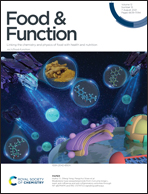Anti-obesity effects of Grifola frondosa through the modulation of lipid metabolism via ceramide in mice fed a high-fat diet†
Abstract
Obesity is characterized by massive fat deposition and is related to a series of metabolic complications, such as insulin resistance (IR) and steatohepatitis. Grifola frondosa (GF) is a basidiomycete fungus and a source of various nutritional ingredients related to human health. In this study, after a systematic analysis of its nutritional ingredients, GF was administered to mice fed a high-fat diet (HFD) to investigate its effects on lipid metabolism. In HFD-fed mice, GF significantly controlled the body weight, blood glucose and related organ indices, and effectively counteracted hyperlipidemia and IR triggered by the HFD. GF administration efficiently alleviated hepatic steatosis and adipocyte hypertrophy, and regulated alanine aminotransferase and aspartate aminotransferase in the liver. An analysis of the intestinal microflora showed that GF reversed obesity-induced dysbiosis by affecting the relative abundance of certain bacteria, reducing lipopolysaccharide production and regulating the superpathway of heme biosynthesis associated with inflammation. According to the results of lipidomics, ceramide, a metabolite related to inflammation and IR, was found to be dysregulated in HFD-fed mice. However, GF regulated the ceramide levels and restored lipid metabolism via the suppression of Toll-like receptor 4/nuclear factor kappa-B signaling, which is involved in inflammation and IR. This study provides the experimental basis for the application of GF as an agent for obesity.



 Please wait while we load your content...
Please wait while we load your content...